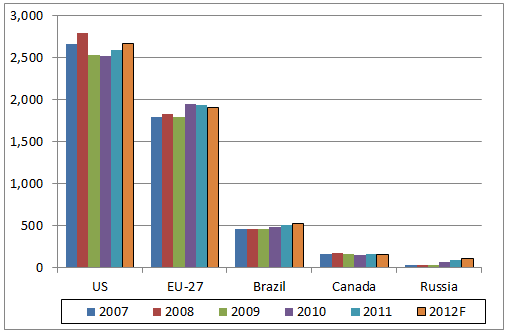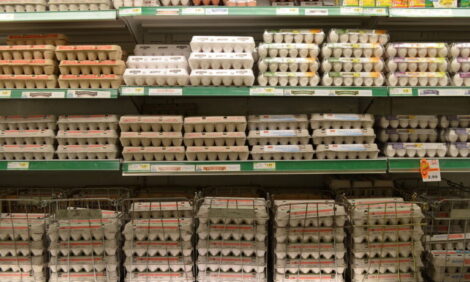



GLOBAL POULTRY TRENDS 2012 - Turkey Output Slowly Heads Towards Six Million Tonnes
Global production of turkey meat in 2012 will come close to 5.75 million tonnes, according to Terry Evans in his latest analysis of the current state and future trends in the global turkey industry.The estimate for 2012 by the USDA of 5.3 million tonnes is understated as it does not include production in some countries in the Americas, Africa, Asia or Oceania. Also, the latest figures for the US have since been revised upwards (Table 1). These changes, coupled with some amendments to the published Food and Agriculture Organisation (FAO) data, mean that the forecasts for 2011 and 2012 in Table 1 are not directly comparable to those for the preceding years, which are taken from the FAO, as this is the one organisation that attempts to present data for all countries.
While, according to the FAO, output expanded from almost 5.1 million tonnes in 2000 to 5.4 million tonnes in 2010 (Table 2), industry growth was slow at 0.5 per cent a year compared with nearly four per cent for chicken meat. Hence, turkey meat's contribution to total poultry meat supplies actually declined over the decade from 7.4 per cent in 2000 to 5.5 per cent in 2010. However, because of a likely underestimate in the FAO data of production in both Russia and Poland, it is possible that total turkey meat output in Europe in 2010 was around two million tonnes.
Although the number of turkeys slaughtered worldwide in 2010 came close to 640 million, this was some 27 million (four per cent) fewer than the 667 million killed in 2000. However, because the average slaughter weight per bird over this period rose by nearly 10 per cent from 7.64kg to 8.37kg, the total volume of meat produced increased by 260,000 tonnes (five per cent) to reach 5.4 million tonnes in 2010.
While total global output has been slow to expand, there has been considerable variation in industry growth between the major regions (Tables 1 and 2 and Figure 1).
Although production in Africa is small - amounting to less than 145,000 tonnes in 2010 - the annual growth rate during the decade averaged more than five per cent. In contrast, in the Americas, which accounted for 3.3 million tonnes or 62 per cent of the world total in 2010, the growth rate has been a much more modest 1.6 per cent a year.
For the rest of the world, the picture is less heartening. Output in Asia fell by more than 30 per cent from 167,000 tonnes to 116,000 tonnes between 2000 and 2010.
Of greater concern to the global situation is the more than one per cent a year decline that has occurred in Europe. Between 2000 and 2010, the number of turkeys killed in this region dropped by 63 million (23 per cent) from 269 million to 206 million. However, as the average slaughter weight rose from 7.35kg to 8.52kg per bird over the period, the reduction in meat output fell by just 11 per cent from 1.98 million tonnes to 1.76 million tonnes. Based on the FAO data in Table 1, some 99 per cent of Europe's turkey production is in European Union member states. However, while the FAO data shows zero turkey meat production in Russia, figures from other sources indicates that this could be at least 100,000 tonnes a year. Also, while the FAO estimate of production in Poland is 100,000 tonnes, another source puts this figure at 280,000 tonnes. Allowing for these two possible discrepancies in the FAO data, total production in Europe in 2010 could have been just over two million tonnes, while the EU's contribution would have amounted to some 1.92 million tonnes or around 94 per cent.
The upswing in global output in 2008 (Tables 1 &2 and Figures 1 & 2) was primarily the result of a substantial expansion in production in the US, which was more than reversed in the following year.
In 2010, the United States accounted for 65 per cent of all slaughterings and 77 per cent of the turkey meat in the Americas, while globally, the corresponding figures were 38 per cent and 48 per cent. Clearly developments in the US industry are key to changes in both the regional and world picture. After peaking at 2.8 million tonnes in 2008, the sector experienced a slump in profits in 2009 and consequently, production contracted to between 2.5 and 2.6 million tonnes in 2009 and 2010, according to both FAO (Table 2) and USDA figures (Table 3 and Figure 2).
For 2011, the latest USDA figures point to an output in the US of 2.59 million tonnes, recovering to 2.67 million tonnes in 2012 although a cut-back to a shade below 2.6 million tonnes is currently expected for 2013. However, two long-term forecasts anticipate growth averaging around one per cent a year; it is unlikely that output will reach 3.0 million tonnes by 2021. Around 50 per cent of birds are grown in just four states - Minnesota, Arkansas, North Carolina and Missouri.
According to Joel Brandenberger, president of the US National Turkey Federation, the turkey industry enjoyed a profitable year in 2011 reflecting slow and managed growth in output, less volatile feed costs, good export markets and a strengthening domestic economy.
Feed costs are a major problem in all countries. In the US since 2006, the price of maize has escalated from US$3 a bushel to around $6. The diversion of maize from feed to biofuel production has been a major factor influencing prices over this period, as the percentage utilised for ethanol products has jumped from 12 per cent to 40 per cent of the maize harvest. Additionally, as a result of the worst drought in half a century, prices have risen further this year with maize traded on the futures market at $8 a bushel at the time of writing, September 2012. Indeed, both maize and soybeans are four times as expensive as they were just four years ago. World Agriculture Supply and Demand Estimates (WASDE) for turkey production in 2013 were lowered in August from July by 2.3 per cent and in view of the latest feed price increases, it would not be surprising if further reduction were applied to future forecasts.

At the start of the last decade, Canada was the second largest turkey meat producer in the Americas with an annual output of some 153,000 tonnes. Since then, production has fluctuated between 145,000 tonnes and 180,000 tonnes (2008) but has since stabilised at around 160,000 tonnes a year (Tables 2 & 3). Production is controlled by the Canadian Turkey Marketing Agency in order to try and guarantee producers a fair return.
In 2001, Brazil took Canada's position in the number two spot in the production league table. Between 2000 and 2010, output in Brazil, according to Food and Agriculture Organisation, more than trebled from 137,000 tonnes to 440,000 tonnes. However, USDA figures put the 2010 figure closer to 485,000 tonnes, with further gains forecast for 2011 and 2012. The impetus to increased production has come from an expanding export business coupled with increased domestic consumption.
Rising feed prices and a slow-down to the growth of domestic demand in Brazil appear to be influencing production as estimates by the USDA's Global Agricultural Information Network (GAIN) point to an increase of only two per cent in 2013 as output climbs to around 520,000 tonnes compared with an estimate of 510,000 tonnes (up four per cent) for 2012. It should be noted that these are not official USDA figures, which show estimates for 2011 and 2012 of 505,000 tonnes and 531,000 tonnes, respectively. According to poultry processing consultant, Fabio G. Nunes of Curitiba, Brazil's poultry industry has passed through an unavoidable and irreversible consolidation process. In line with the trend towards business globalisation, a few Brazilian companies have acquired poultry companies in America, Northern Ireland in the UK and Argentina.

Although there are differences between the FAO data and USDA figures in the turkey meat production figures in the European Union, they both show a reduction in the years from 2005 to 2009. A third source, the annual report of the Association of Poultry Processors and Poultry Trade in EU countries (AVEC) reveals the same trend although the annual figures differ from the other two sources. According to AVEC, total EU output in 2010 totalled a little over 1.8 million tonnes, which compares with 1.95 million tonnes for the USDA and 1.74 million tonnes for the FAO. However, on the assumption that the FAO figure for Poland is understated by some 180,000 tonnes, then this would raise the FAO's EU total to 1.92 million tonnes.
AVEC's figures for the individual member countries reveal contrary trends. For Germany, output between 2005 and 2010 rose from 349,000 tonnes to 439,000 tonnes, while the corresponding figures for Poland were 257,000 tonnes and 280,000 tonnes. In contrast, the industries in France, the UK, Hungary and Italy have contracted in recent years.
For the period 2010 to 2012, USDA economists anticipate EU production slipping a shade from 1.95 million tonnes to 1.91 million tonnes. However, the latest report by the USDA's Global Agricultural Information Network (GAIN) is more optimistic, considering that EU turkey meat output in both 2012 and 2013 will rise a shade to 2.0 million tonnes.
While the official reports supplied by the Russian Federation to the FAO do not indicate any turkey meat production, other sources assess that output has escalated rapidly over the past decade or so from just 1,000 tonnes to more than 100,000 tonnes in 2012. In addition, recent press reports indicate that further significant developments are taking place. One states that a Spanish company, Grupa Fuerte, and Russia's Cherkizovo Group have joined forces to build in 2014 a turkey enterprise to produce 25,000 to 30,000 tonnes initially, increasing to 50,000 tonnes by 2015.
Additionally, several domestic companies are expected to establish turkey enterprises with a combined capacity in excess of 30,000 tonnes a year. A USDA GAIN report anticipates production amounting to 105,000 tonnes in 2013 but another forecast that output in 2015 could treble the 90,000 tonnes produced in 2011 would appear to be overly optimistic.
December 2012











